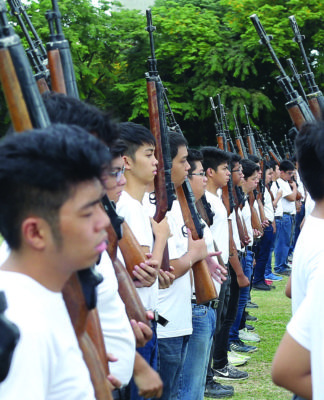THE SEVERE Acute Respiratory Syndrome (SARS) scare continues. The extent of the local transmission worsens especially in most East Asian countries as the World Health Organization (WHO) has reported 8,046 cumulative number of cases with 682 deaths.
In the Philippines, 10 SARS cases with two deaths had been reported.
In early April, Adela Catalon came home from Toronto, Canada and was admitted to the hospital because of SARS-like symptoms. Her case was later confirmed as SARS, and the disease later on also claimed her father.
However, Dr. Margarita Cayco of the UST Hospital’s (USTH) Department of Infectious Medicine assures that, locally, the killer virus has not yet spread uncontrollably.
The WHO affirms that the situation in the country has been “well contained” with no increased transmission risk because the Department of Health (DOH) has immediately traced the carriers and placed them on quarantine. It also did not recommend any travel restrictions to the country.
UST’s campaign
On measures to contain SARS or prevent it from spreading or entering the University, Cayco said the USTH would not admit SARS patients. “The official stand is not to admit. Although, we refer them immediately to the San Lazaro Hospital and to the Research Institute for Tropical Medicine (RITM),” Cayco said.
In a memorandum last April 10, Fr. Juan Ponce, O.P., UST Vice Rector and USTH chairman governing board, ordered the non-admittance of SARS patients.
“At first, there were really great efforts on the part of our medical staff and there was already a contingency plan on the admittance of patients diagnosed with SARS. However, the DOH has set only San Lazaro and RITM to treat SARS patients. In case of SARS, we are not prepared to treat, we are only prepared to diagnose,” Fr. Ponce said.
Fr. Ponce also told the Varsitarian that even if the USTH had the facilities, it would be unadvisable to accept SARS patients since the hospital is inside the University campus and it might put the students at risk.
“We are very close to the hospital and the students might get it,” Fr. Ponce said.
Initially, the Sto. Nino ward of the USTH was being prepared to admit SARS patients, but after the DOH guideline, the plans changed. Now, if a patient is diagnosed with SARS in the emergency room, the hospital will call a representative from San Lazaro or RITM.
“We are ready to help, that is, by referring them to these hospitals. We will not just ignore them or drive them away,” Fr. Ponce clarified.
Patients are already being required to answer a questionnaire before entering the hospital to determine whether the person is experiencing SARS symptoms or has just arrived from SARS-infected areas like Hongkong, Mainland China, and Canada.
The UST Health Service has also heightened awareness on campus through posters and flyers containing information on the disease. The flyers contain the basic information on SARS, WHO recommendations, and the interim domestic guidance for management of school students exposed to SARS.
According to UST Health Service director Dr. William Olalia, a SARS update will also be posted on the Tomasino website.
The UST Educational Technology (EdTech) Center is also preparing a video on SARS information and infection control which will be shown during the freshmen orientation in June.
In addition, USTH chief operating officer Hernando Veloso has organized a SARS task force that will handle protocols in the management of SARS. Cayco was appointed head of the group.
Further, UST students who are medical interns at the San Lazaro Hospital have already been pulled out according to Cayco.
Staying healthy
According to Olalia, the best way to fight SARS is by keeping the body healthy.
“You have to practice proper hygiene always,” Olalia said. “You must also keep your immune system high by quitting smoking and avoiding stress, since the disease is viral in origin.”
Cayco also advises intake of the right food and avoiding crowded areas even if there is still no local transmission. Moreover, she cautions against non-essential trips to SARS-infected countries.
There is still no cure for SARS. But according to Cayco, antibiotics used to treat pneumonia can be used. She said the medicines that are promoted as anti-SARS have no scientific evidence. The medicines that are being advertised to cure SARS are specifically for pneumonia and flu only.
Cayco also clarified that the DOH still not recommended wearing masks, which is only for healthcare workers.
SARS is still a mystery. Scientists are still deciphering and performing experiments to determine the real identity of the virus and find a cure. And we wait for answers. Brix Gil M. Bayuga















